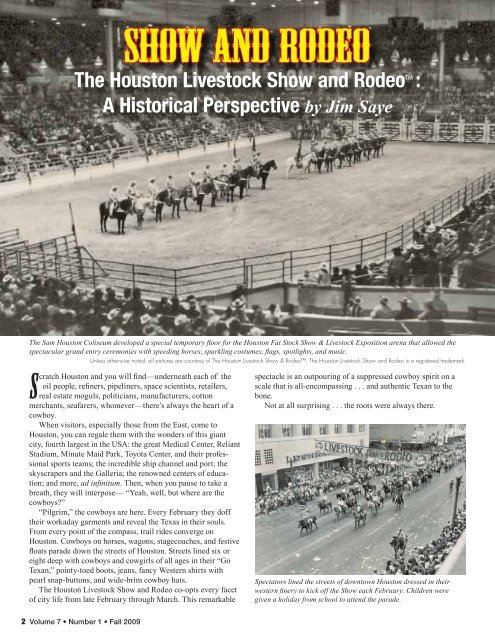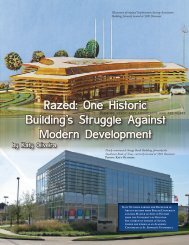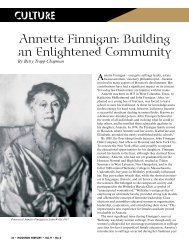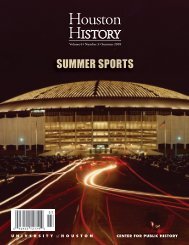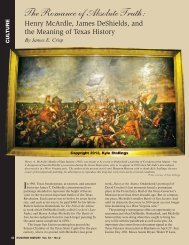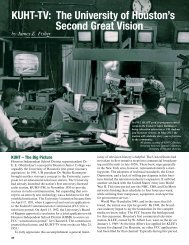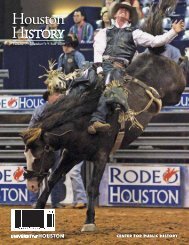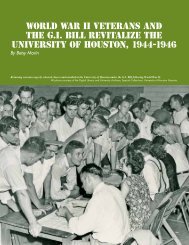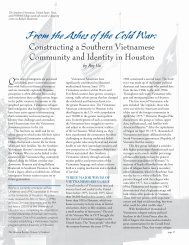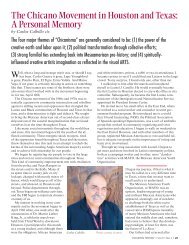SHOW AND RODEO - Houston History Magazine
SHOW AND RODEO - Houston History Magazine
SHOW AND RODEO - Houston History Magazine
Create successful ePaper yourself
Turn your PDF publications into a flip-book with our unique Google optimized e-Paper software.
<strong>SHOW</strong> <strong>AND</strong> <strong>RODEO</strong><br />
The <strong>Houston</strong> Livestock Show and Rodeo TM :<br />
A Historical Perspective by Jim Saye<br />
The Sam <strong>Houston</strong> Coliseum developed a special temporary floor for the <strong>Houston</strong> Fat Stock Show & Livestock Exposition arena that allowed the<br />
spectacular grand entry ceremonies with speeding horses, sparkling costumes, flags, spotlights, and music.<br />
Unless otherwise noted, all pictures are courtesy of The <strong>Houston</strong> Livestock Show & Rodeo. The <strong>Houston</strong> Livestock Show and Rodeo is a registered trademark.<br />
S<br />
cratch <strong>Houston</strong> and you will find—underneath each of the<br />
oil people, refiners, pipeliners, space scientists, retailers,<br />
real estate moguls, politicians, manufacturers, cotton<br />
merchants, seafarers, whomever—there’s always the heart of a<br />
cowboy.<br />
When visitors, especially those from the East, come to<br />
<strong>Houston</strong>, you can regale them with the wonders of this giant<br />
city, fourth largest in the USA: the great Medical Center, Reliant<br />
Stadium, Minute Maid Park, Toyota Center, and their professional<br />
sports teams; the incredible ship channel and port; the<br />
skyscrapers and the Galleria; the renowned centers of education;<br />
and more, ad infinitum. Then, when you pause to take a<br />
breath, they will interpose— “Yeah, well, but where are the<br />
cowboys?”<br />
“Pilgrim,” the cowboys are here. Every February they doff<br />
their workaday garments and reveal the Texas in their souls.<br />
From every point of the compass, trail rides converge on<br />
<strong>Houston</strong>. Cowboys on horses, wagons, stagecoaches, and festive<br />
floats parade down the streets of <strong>Houston</strong>. Streets lined six or<br />
eight deep with cowboys and cowgirls of all ages in their “Go<br />
Texan,” pointy-toed boots, jeans, fancy Western shirts with<br />
pearl snap-buttons, and wide-brim cowboy hats.<br />
The <strong>Houston</strong> Livestock Show and Rodeo co-opts every facet<br />
of city life from late February through March. This remarkable<br />
spectacle is an outpouring of a suppressed cowboy spirit on a<br />
scale that is all-encompassing . . . and authentic Texan to the<br />
bone.<br />
Not at all surprising . . . the roots were always there.<br />
Spectators lined the streets of downtown <strong>Houston</strong> dressed in their<br />
western finery to kick off the Show each February. Children were<br />
given a holiday from school to attend the parade.<br />
2 Volume 7 • Number 1 • Fall 2009
COWBOY FROM DAY ONE<br />
In 1836, when the Allen Brothers were busily founding a city,<br />
they wisely hired another pair of brothers to do the real work of<br />
surveying the city, and laying out the streets. Thomas Borden<br />
and brother Gail laid out the streets on a grid pattern. All of<br />
the streets were planned with an eighty-foot width, except two.<br />
Main Street was to be ninety feet wide, and Texas Avenue was<br />
expanded to a width of 100 feet to accommodate fourteen head<br />
of longhorn cattle moving abreast across the city to the stockyards<br />
and port. Later, Lubbock Street was named for early settler<br />
Francis R. Lubbock, who had an 843 acre ranch in the area<br />
where Hobby Airport now stands. Lubbock’s cattle brand and<br />
earmarks remain listed in the “Records of Marks and Brands”<br />
book in the Harris County clerk’s office. 1<br />
“<strong>History</strong> of the Texas cattle industry is full of unlikely events<br />
and circumstances,” wrote Leon Hale in 1988. “The settlers<br />
who came into this state from the east weren’t really livestock<br />
raisers. Most were farmers and knew little about ranching. But<br />
when they saw the oceans of Texas grass waving over free or<br />
cheap land, they began having pleasant dreams.” 2<br />
TOP CATTLE COUNTY IN THE TOP CATTLE STATE<br />
The 1932 Grand Champion was purchased by George Kelly for $504.<br />
The 1948 champion shown here, an Angus exhibited by Robert H.<br />
Johnson of Goldwaithe, Texas, was purchased by Cliff Rampy for<br />
$12,500.<br />
The bountiful, nutritious grasses, the abundant sources of good<br />
water, the moderate climate, and the access to markets made<br />
<strong>Houston</strong>/Harris County a center for raising cattle. For much<br />
of the twentieth century, Harris County was the leading Texas<br />
county in cattle production with adjacent counties, Brazoria and<br />
Wharton, close behind.<br />
Some figures from the Texas Almanac illustrate the extent<br />
of Harris County’s lead. The top three counties in 1954: Harris<br />
– 113,426 head, Brazoria – 96,801 head, Wharton – 82,286<br />
head. In 1959: Harris – 105,230 head, Wharton – 87,059 head,<br />
Brazoria – 81,763 head. THEN, the top three counties in 1964:<br />
Brazoria – 98,388 head, Gonzales – 96,144 head, Harris –<br />
95,829. By 1969, Harris County ranked eleventh, with 86,000<br />
The 2009 Grand Champion Junior Market Steer was exhibited by<br />
Christopher Barton of the Jarrell FFA and sold for $300,000 to Jim<br />
McIngvale of Gallery Furniture.<br />
head. In 1974, even though Harris County held a substantial<br />
94,194 head of cattle, it stood tenth among the 254 Texas<br />
counties. 3<br />
The Texas Almanac, 1956-1957 Edition, states, “Cattle raising<br />
is the oldest of Texas’ present large industries . . . From the<br />
very beginning of the livestock industries in Texas, it has been<br />
a story of breeding up the original scrub stock—the Longhorn<br />
beef cattle, the blue-john milk cattle—into the fine blooded<br />
stock on Texas farms and ranches today.” “Breeding up” is easier<br />
said than done. In the early twentieth century, knowledgeable<br />
cattlemen asserted that the outstanding Texas cattle could be<br />
seen only at the big livestock exposition (and legendary rodeo)<br />
in Fort Worth. Some mentioned San Antonio; Abilene, Pecos,<br />
San Angelo, Nacogdoches, Lubbock, and other cattle centers<br />
were respected as leaders in breeding practices. <strong>Houston</strong> area<br />
cattlemen were making advances, but they received less notice. 4<br />
A TOP H<strong>AND</strong> . . . WITH A TOP PLAN<br />
James W. Sartwelle was a prominent<br />
<strong>Houston</strong> businessman who ran<br />
the Port City Stockyards—a job that<br />
required mastery of the infinite details<br />
of the cattle business. In order to stay<br />
abreast of the significant developments<br />
in the cattle industry, Sartwelle<br />
made frequent trips to the leading<br />
livestock markets in the southwest.<br />
J. W. Sartwelle was a<br />
prominent <strong>Houston</strong> business<br />
leader: president of<br />
Port City Stockyards. He<br />
founded the <strong>Houston</strong> Fat<br />
Stock Show and Livestock<br />
Exposition and served<br />
as its first president from<br />
founding in 1932 to 1948.<br />
His observations persuaded him<br />
that the cities where livestock shows<br />
and competitions were held drew a<br />
better quality of livestock. Sartwelle<br />
believed that if an annual livestock<br />
exposition could make a substantial<br />
improvement in breeding and raising<br />
practices, then <strong>Houston</strong> should<br />
organize and produce an exposition.<br />
Preferably, the most popular, celebrated,<br />
and beneficial livestock show in the State of Texas. So<br />
he took steps to make it a reality.<br />
To set up an organizational meeting, Sartwelle ran an ad<br />
in the <strong>Houston</strong> newspapers seeking <strong>Houston</strong>ians interested in<br />
founding a local livestock competition and show, along estab-<br />
Volume 7 • Number 1 • Fall 2009 3
lished lines. The first meeting, in the Texas State Hotel, on<br />
January 30, 1931, consisted of J. W. Sartwelle and six “interested<br />
persons.” 5<br />
Sartwelle was a large, aggressive man whose enthusiasm<br />
and commitment inspired the “interested persons” to pledge<br />
their support and join in the founding of the “<strong>Houston</strong> Fat Stock<br />
Show.” The group elected Sartwelle to be president; J. Howard<br />
West, Marcus Meyer, W. C. Munn, and Julian A. Weslow were<br />
elected vice presidents. W. S. Cochran was elected treasurer,<br />
and Haygood Ashburn was elected secretary. The influence of<br />
these seven men spread to their families, their friends, business<br />
associates, farmers, ranchers, and real, authentic working cowboys!<br />
Volunteers turned out to perform the myriad tasks that<br />
required attention to produce an organized, large-scale, countywide<br />
endeavor. 6<br />
On April 30, 1932, a year of preparation culminated in the<br />
first <strong>Houston</strong> Fat Stock Show. The show ran through May 4,<br />
in the huge, wooden Sam <strong>Houston</strong> Hall on Bagby Street. This<br />
historic 25,000-seat auditorium was built for the 1928 National<br />
Democratic Convention as a result of the efforts of <strong>Houston</strong><br />
businessman Jesse H. Jones. Some 2,000 exhibitors showed<br />
livestock. Spectators watched the judging, and were entertained<br />
by Billie Ehman and his trick horse “Baby Doll.” While an official<br />
rodeo was not held in combination with the first Fat Stock<br />
Show, authentic bucking bronc action took place in the livestock<br />
arena courtesy of Emil Marks, who owned the LH-7 Ranch in<br />
Barker and supplied the horses for the cowboy riders. 7<br />
Although the first <strong>Houston</strong> Fat Stock Show lost $2,800, the<br />
effort was judged by one and all as a success and a new asset<br />
for the city. Plans were immediately set in motion for the second<br />
show in 1933. 8<br />
BIGGER <strong>AND</strong> BETTER – IN THE COLISEUM <strong>AND</strong> MUSIC HALL<br />
From the first Show in 1932 through the much-expanded Show<br />
in 1936, Sam <strong>Houston</strong> Hall proved more than adequate. But in<br />
1937, <strong>Houston</strong> was ready for something grander; something with<br />
air conditioning! So the hall was razed, and the elegant Sam<br />
<strong>Houston</strong> Coliseum and Music Hall built. No <strong>Houston</strong> Fat Stock<br />
Show was held in 1937; the organization devoted that year to<br />
preparations for a revamped Show in 1938.<br />
The one-year hiatus proved to be of immeasurable value<br />
to the Show. The ranks of volunteers swelled. The <strong>Houston</strong><br />
Chapter of the Junior Chamber of Commerce (soon to become<br />
the largest chapter in the world) helped with ticket sales and<br />
promotional endeavors. The new Coliseum and Music Hall offered<br />
state of the art facilities. The quantity and quality of the<br />
livestock exhibited and judged multiplied, and horse shows were<br />
held. Bands performed, including local favorites such as fiddler<br />
Leon “Pappy” Selph who played the western swing music that<br />
was wildly popular on the radio and in the honky-tonks.<br />
Saddle bronc riding evolved from breaking horses for use on a ranch. To receive a score, the cowboy’s feet must touch the horse’s shoulders on the<br />
first jump out of the chute, and he must stay on for eight seconds. Points are awarded to the horse for bucking action, and to the rider for spurring<br />
and maintaining balance.<br />
4 Volume 7 • Number 1 • Fall 2009
In February 1940, radio and honky-tonk stars Curly Fox (center)<br />
and Texas Ruby (seated on fender) took their Gulf Company sponsored<br />
panel truck and staged impromptu performances throughout<br />
downtown to promote ticket sales for the <strong>Houston</strong> Fat Stock Show.<br />
In the 1950s, the pair had the most popular live prime time show on<br />
KPRC-TV.<br />
Photo courtesy Bob Bailey Studios Photographic Archive, Dolph<br />
Briscoe Center for American <strong>History</strong>, The University of Texas at Austin.<br />
FIRST STOCK <strong>SHOW</strong> PARADE – FIRST <strong>RODEO</strong><br />
In her definitive book, February Fever, Lynne Chesnar described<br />
the first <strong>Houston</strong> Fat Stock Show parade, “The parade<br />
in 1938 was a tremendous success. Headed by a mounted police<br />
escort and color guard, the parade line-up included state, county<br />
and city officials, a 20-piece band and officials of the <strong>Houston</strong><br />
Fat Stock Show and Livestock Exposition. It also included a<br />
65-piece cowboy band under the direction of Cliff Drescher<br />
and drum and bugle corps from area high schools, including<br />
the famous all-girl ‘Black Battalion’ from Sam <strong>Houston</strong> High<br />
School in <strong>Houston</strong>,” which was the only all-girl marching drum<br />
and bugle corps to perform under the baton of the great John<br />
Phillip Sousa. 9<br />
J. W. Sartwelle announced that the 1938 Show would be<br />
“The Show of Shows.” The excitement and wonder stirred by<br />
the downtown parade set the stage for the record-setting Show.<br />
Each performance opened with the Grand Entry spectacular<br />
in the arena of the Coliseum. There was special entertainment<br />
and the drama of livestock judging and auctions. But the<br />
favorite new element was the thrilling, action-packed rodeo.<br />
Reese Lockett, a respected rodeo hand and mayor of Brenham,<br />
served as the rodeo’s producer. Cowboy contestants flocked to<br />
<strong>Houston</strong> for this event. Texas cowboys competed with top hands<br />
from California, Nevada, New Mexico, Colorado, Oklahoma,<br />
and even Calgary. There were five rodeo events: bareback bronc<br />
riding, saddle bronc riding, bull riding, steer wrestling, and calf<br />
roping. Barrel racing and team roping were added in later years.<br />
One of the Texas cowboys who competed in 1938 was<br />
Warren Gunn from <strong>Houston</strong>. In 2000, Gunn was selected for<br />
the Texas Professional Rodeo Cowboys Hall of Fame. In an<br />
interview on the occasion of this honor, Gunn related memories<br />
of the 1938 competition. “I rode bareback and the bulls,” said<br />
Gunn. “Most of the bulls were Brahmas. My life-long friend,<br />
Gerald Abbott, worked pick-up at the 1938 rodeo. He continued<br />
to work pick-up for the <strong>Houston</strong> Rodeo for many years. Abbott<br />
worked pick-up at the Huntsville Prison Rodeo for thirty years.”<br />
The pick-up man is the cowboy in the arena on horseback who<br />
“picks up” the bareback or saddle bronc rider from his horse after<br />
the ride. Even though Gunn spent much of his life traveling<br />
to compete in rodeos across the country, he considered <strong>Houston</strong><br />
his home until he retired to Fredericksburg to be near his ranch.<br />
He died in 2002. 10<br />
Another “first” followed the 1938 <strong>Houston</strong> Fat Stock Show<br />
and Livestock Exposition when the event’s leaders decided to<br />
offer memberships in the Show for minimal annual dues. This<br />
organizational procedure has proved to be practical and successful.<br />
Wilhemina Beane purchased the first one-year membership<br />
for $5.00 on June 24, 1938. Beane, a writer with the <strong>Houston</strong><br />
Press, was a Show volunteer and became the first woman director<br />
of the <strong>Houston</strong> Fat Stock Show. 11<br />
Throughout his tenure as founder/president of the <strong>Houston</strong><br />
Fat Stock Show and Livestock Exhibition, J. W. Sartwelle was a<br />
flamboyant, forceful leader. He was not only a brilliant planner<br />
and organizer, but also a natural showman and impresario.<br />
Even so, he never lost sight of his original objectives: to promote<br />
<strong>Houston</strong> as a convenient and profitable marketplace for<br />
livestock, and to encourage area ranchers to produce improved<br />
livestock through better breeding and feeding practices. Over<br />
the years, the educational aspect of the Show expanded, and this<br />
has paid vast dividends in the billion-dollar agricultural and<br />
agribusiness segment of Harris County’s economy. 12<br />
DECEMBER 7, 1941 – WATERSHED OF THE 20 TH CENTURY<br />
The entire world experienced drastic change on Pearl Harbor<br />
Day. Certainly, the <strong>Houston</strong> Fat Stock Show and Livestock<br />
The sign on this chuckwagon proclaims it to be an “OFFICIAL<br />
WAGON – HOUSTON FAT STOCK <strong>SHOW</strong>.” Inclement weather almost<br />
always marks the arrival of the Trail Rides and the traditional downtown<br />
parade.<br />
Volume 7 • Number 1 • Fall 2009 5
Today, he may look like a rodeo clown, and<br />
sometimes act like a rodeo clown, but as<br />
this photograph demonstrates, he is really a<br />
bullfighter--which is now his proper title. His<br />
job is to divert the bull away from the exiting<br />
rider.<br />
At each rodeo twenty-eight youngsters compete for fourteen calves in the exciting, and often<br />
chaotic calf scramble. They must get a rope halter on the calf and bring it across the finish line.<br />
They then receive a certificate to purchase a calf to raise and show.<br />
Rodeo clown Quail Dobbs entertained<br />
<strong>Houston</strong> audiences for decades as the clown<br />
in the barrel.<br />
6 Volume 7 • Number 1 • Fall 2009
Exposition was not immune from world events. Plans for the<br />
Show in early 1942 were all in place. Should the 1942 Show be<br />
cancelled? President Sartwelle and the association’s executive<br />
committee decided to proceed as planned—an action of visionary<br />
wisdom that proved successful.<br />
“Grand champion steer buyers during the war years were<br />
restaurateurs George P. Kelley, Bill Williams, and Virgil<br />
Shepherd of Grand Prize Brewery,” wrote Maudeen Marks in<br />
a lengthy story for the February 12, 1995, issue of the <strong>Houston</strong><br />
Chronicle. “In all, a lot of fine folks gave their best and came<br />
through the war era with a sense of pride, having helped provide<br />
meat for the Army, and having done so with a camaraderie that<br />
is still magic in stock show circles.” She continued, “Despite<br />
rationing, war quotas to be met, inconveniences and personal<br />
stress, the <strong>Houston</strong> Fat Stock Show prospered in every way.<br />
THE TOP COWBOY MOVIE STAR PERFORMS AT THE<br />
HOUSTON <strong>SHOW</strong><br />
Fittingly, the first “star” entertainer brought in for the <strong>Houston</strong><br />
Fat Stock Show was a native Texan. Born in Tioga, Gene Autry<br />
achieved worldwide fame as the “Singing Cowboy” in numerous<br />
Western movies. In Hollywood, he added a new dimension<br />
to the ever-popular Western genre and along the way, continued<br />
to turn out hit recordings, including “Tumbling Tumbleweeds,”<br />
“Back in the Saddle Again,” and “You Are My Sunshine.” Additionally,<br />
his recording of “Rudolph, the Red-Nosed Reindeer”<br />
reached legendary status and is now a Christmas tradition.<br />
Harris County Sheriff T. A. Binford covered his desk with hide and<br />
horns from a champion steer he bought at a <strong>Houston</strong> Fat Stock Show<br />
auction. Binford was sheriff from 1918 to 1937. He rode his white mule<br />
“Madame Queen” in Show parades and on several Salt Grass Trail<br />
Rides.<br />
Photo courtesy Bob Bailey Studios Photographic Archive, Dolph<br />
Briscoe Center for American <strong>History</strong>, The University of Texas at Austin.<br />
It came out of World War II with money in the bank, the calf<br />
scramble, better livestock housing, an organized rodeo visit for<br />
the handicapped, the quarter horse show and a half-dozen and<br />
more new committees. It gained in membership, efficiency and<br />
sophistication.” Maudeen Marks, daughter of Emil H. Marks,<br />
one of the early directors of the Show, volunteered with the<br />
<strong>Houston</strong> Fat Stock Show & Livestock Exposition from its early<br />
beginnings in 1932. During the war years she handled publicity<br />
for the Show. Maudeen remained active well into her eighties,<br />
and died at the age of ninety on March 20, 2009, in Bandera,<br />
Texas. 13<br />
Gene Autry’s horse Champion shows off his unusual intelligence and<br />
agility in the arena of the Coliseum. The pair starred in ninety-five<br />
movies, and Autry, the “Singing Cowboy” recorded more than 635<br />
songs.<br />
Photo courtesy Bob Bailey Studios, Photographic Archive, Dolph Briscoe<br />
Center for American <strong>History</strong>, The University of Texas at Austin.<br />
Superstar Autry and his famous horse, Champion, were a<br />
grand hit with <strong>Houston</strong> audiences. He brought business to a halt<br />
when he led the rodeo parade down Main Street. The Coliseum<br />
was packed for his six appearances in 1942, 1943, 1944, 1947,<br />
1948, and 1955. Autry and his business partner Everett Colborn,<br />
from Dublin, Texas, produced the <strong>Houston</strong> Rodeo for several<br />
years, as well as the rodeo in New York’s Madison Square<br />
Garden during its final years. 14<br />
The “Calf Scramble” was added to the program as a rodeo<br />
event in the 1940s. This energetic, somewhat chaotic event has<br />
given thousands of youngsters an opportunity to become “miniature”<br />
ranchers, with the responsibility for “hands-on” cattle<br />
raising.<br />
Change was the word for the 1940’s. The world changed.<br />
Texas changed. <strong>Houston</strong> changed, and with it, the <strong>Houston</strong><br />
Fat Stock Show and Livestock Exposition. J. W. Sartwelle, the<br />
Volume 7 • Number 1 • Fall 2009 7
The bull rider, hanging on to a flat-braided rope with one hand, must stay on the bull for an eight-second ride. If his free hand<br />
touches himself or the bull, he is disqualified. While he is not required to spur, it does add to his score. Points are awarded for the<br />
bucking action of the bull and the cowboy’s style and control for a total score.<br />
8 Volume 7 • Number 1 • Fall 2009
strong hand at the helm, retired from the presidency in 1948,<br />
and W. Albert Lee was chosen as his successor. Lee, a successful<br />
businessman who owned hotels and a radio station,<br />
enthusiastically worked in Show activities. His management<br />
style differed from that of Sartwelle, but he was effective and<br />
popular. Lee made his mark in the Fat Stock Show through his<br />
leadership on the advance ticket sales committee and his coordination<br />
of the first Rodeo and the first Rodeo parade. W. Albert<br />
Lee will be remembered also as “the man who brought television<br />
to <strong>Houston</strong>.” He outmaneuvered other applicants to gain the<br />
first license issued by the Federal Communications Commission<br />
for a station in the <strong>Houston</strong> area. His station, KLEE-TV, went<br />
on the air on January 1, 1949. Lee sold it to Governor William<br />
Hobby in 1950, and the station became KPRC-TV. 15<br />
Beloved stars of Western movies, personal appearances, and television,<br />
Roy Rogers and Dale Evans entertained at the <strong>Houston</strong> Show<br />
eight times from 1950 to 1972. They always enjoyed a special popularity<br />
with <strong>Houston</strong> audiences.<br />
Photo courtesy Bob Bailey Studios Photographic Archive, Dolph<br />
Briscoe Center for American <strong>History</strong>, The University of Texas at Austin.<br />
GO TEXAN IN THE FABULOUS FIFTIES<br />
The phenomenal progression of success for the <strong>Houston</strong> Fat<br />
Stock Show through the 1950s reflects the leadership of Show<br />
presidents Ralph A. Johnston, 1951-1954; Archer Romero,<br />
1954-1957; and Douglas B. Marshall, Sr., 1957-1960. During<br />
the 1950s, Charles Giezendanner proved beyond any doubt<br />
that “should you happen to scratch a <strong>Houston</strong>ian, beneath the<br />
modern apparel you likely will find the big heart of a cowboy.”<br />
Advertising executive Giezendanner, restaurateur Bill Williams,<br />
and others sprang the “Go Texan Days” promotion on an astonished<br />
city and drew an immediate, powerfully positive response.<br />
Bulldogging, or steer wrestling, is a timed event. The cowboy must leap from his saddle onto a speeding steer weighing as much as 750 pounds,<br />
grab his horns, and throw him to the ground resting on his side with all four legs pointing in the same direction.<br />
Volume 7 • Number 1 • Fall 2009 9
Educational Programs and Scholarships<br />
by Aimee L’Heureux<br />
Since the scholarship and educational program support began<br />
in 1957, more than $235 million has been committed to<br />
Texas students for their education. Currently, 1,934 students are<br />
furthering their education with the <strong>Houston</strong> Livestock Show and<br />
Rodeo scholarships. Enrolled students are attending eighty-eight<br />
different Texas colleges and universities. In order to qualify for<br />
any of the scholarships, students must demonstrate academic<br />
potential, citizenship/leadership, and financial need. Winners<br />
may major in any field of study leading to a bachelor’s degree;<br />
however, they must attend a college or university in Texas.<br />
These three students are a sampling of the many scholarship<br />
recipients who were able to accomplish their goals and, today,<br />
follow the example set by the <strong>Houston</strong> Livestock Show and Rodeo’s<br />
scholarship program by giving back to the community.<br />
Kristina Kovar, a Rodeo Art Scholar from Lamar<br />
Consolidated High School who graduated in 2005, says that<br />
The <strong>Houston</strong> Livestock Show and Rodeo Scholarship made a<br />
difference in her life because it enabled her to attend college<br />
and pursue her dreams without worrying about how to pay her<br />
expenses or divide her time between work and school. Her artwork<br />
was chosen for the Rodeo Art Auction and sold for $9,000.<br />
She says the auction was bittersweet because she knew that she<br />
would never again see the picture that she had poured hundreds<br />
of hours into; but much to her shock and surprise, the artwork<br />
was donated back to her. Kristina says that her life is now full of<br />
unlimited possibilities because of the generosity of the scholarship<br />
donors and the <strong>Houston</strong> Livestock Show and Rodeo. Since<br />
graduating summa cum laude from the University of <strong>Houston</strong><br />
with a B.F.A. in Interior Design and a minor in Architecture,<br />
she is now attending Graduate School at UH, seeking a master’s<br />
degree in Architecture, as well as being a student design intern<br />
at Newberry Campa Architects. Her time spent with the rodeo<br />
through the years, volunteering at their scholarship booth and<br />
speaking at one of their meetings were memorable and rewarding<br />
experiences that she treasures to this day. Kristina’s ultimate<br />
goal is to give something back to the people and community<br />
that have given her so much. Through architecture, she hopes to<br />
positively contribute to the fabric of society.<br />
Audrie Luna, a Metropolitan Scholarship recipient, 2002-<br />
2006, says that The <strong>Houston</strong> Livestock Show and Rodeo scholarship<br />
helped her to attain her goal, while also providing her<br />
family with the peace of mind that she would be able to attend<br />
college even though they could not assist financially. Audrie<br />
Luna graduated from the University of <strong>Houston</strong> in 2006 with a<br />
B.S. in Psychology and a minor in Sociology. She is currently<br />
working at LINN Energy, a mid-sized oil and gas company in<br />
Downtown <strong>Houston</strong> as an executive assistant for the company’s<br />
top three executives. In her spare time, she volunteers with<br />
CanCare, a local non-profit organization whose mission is to improve<br />
the quality of life for cancer patients and their families.<br />
Gabynely Galvan-Solis graduated from Furr High School<br />
in the top five percent of her class and always dreamt of going to<br />
college. Coming from a very low income Hispanic family, she<br />
wanted to be one of the first in her family to obtain a bachelor’s<br />
degree. College was not an option unless she riddled herself<br />
with student loan debt. Her parents only achieved a middle<br />
school education and, even though she knew they wanted to<br />
10 Volume 7 • Number 1 • Fall 2009<br />
help financially, they did not know how to make this dream a<br />
reality. With her high school counselors and teachers pushing<br />
her to apply for as many scholarships as possible, the final tally<br />
was between thirty-five and forty applications. One by one<br />
she was rejected. Just as she was beginning to lose hope, she<br />
received a big yellow envelope in the mail that said she had been<br />
awarded $10,000 from the <strong>Houston</strong> Livestock Show and Rodeo.<br />
Gabynely Solis graduated in May of 2008 from the University<br />
of <strong>Houston</strong> majoring in Public Relations and minoring in<br />
Russian. Since graduation she has been working at the College<br />
of Optometry at the University of <strong>Houston</strong> as a Pediatric<br />
Research Coordinator. The program offers patients services,<br />
such as free eye exams, free eye care, and free eyewear.<br />
Aimee L’Heureux is a master’s student in history at the University<br />
of <strong>Houston</strong>.<br />
Current scholarships through the <strong>Houston</strong><br />
Livestock Show and Rodeo include:<br />
FFA Scholarship: 70 four-year scholarships at $15,000<br />
each, statewide.<br />
4-H: 70 four-year scholarships at $15,000 each, statewide.<br />
FCCLA: 10 four-year scholarships at $15,000 each, statewide.<br />
Metropolitan: 214 four-year, $15,000 scholarships to<br />
outstanding students graduating from <strong>Houston</strong>-area public<br />
school districts in Brazoria, Chambers, Fort Bend, Galveston,<br />
Harris, Liberty, Montgomery, and Waller Counties.<br />
Opportunity: 100 four-year, $15,000 scholarships to<br />
outstanding students graduating from specified school districts<br />
within Harris, Brazoria, Chambers, Fort Bend, Galveston,<br />
Liberty, Montgomery, and Waller Counties.<br />
Area Go Texan: 70 four-year, $15,000 scholarships<br />
presented to outstanding eligible students representing the<br />
counties participating in the Show’s Area Go Texan program.<br />
An additional 10 awards are given at large to students within<br />
the 60 counties represented in the Area Go Texan Scholarship<br />
Program.<br />
school art: 15 four-year scholarships at $15,000 each.<br />
Hildebrand: one four-year scholarship at $15,000.<br />
Gabynely Solis (right)<br />
was able to make her<br />
dream come true,<br />
becoming the first in<br />
her family to graduate<br />
from college, with much<br />
thanks to the <strong>Houston</strong><br />
Livestock Show and<br />
Rodeo Scholarship program.<br />
She is joined by<br />
Chairman of the Texas<br />
Railroad Commission,<br />
the Honorable Elizabeth<br />
Ames Jones.
All of <strong>Houston</strong> rushed to dress in wide-brimmed cowboy hats,<br />
jeans, and boots, and to participate in one way or another in<br />
the <strong>Houston</strong> Fat Stock Show and Livestock Exposition. This<br />
had to be one of the most successful community promotions in<br />
<strong>Houston</strong> history. 16<br />
Another major innovation in the 1950s was the scholarship<br />
program. The first scholarship was presented in 1957 to Ben<br />
Dickerson of <strong>Houston</strong> in the amount of $2,000. Officials quickly<br />
recognized this community service program was an area with<br />
the potential for future growth. Today it has become a centerpiece<br />
of the program. 17<br />
The <strong>Houston</strong> Fat Stock Show and Rodeo included the Annual<br />
Rodeo Queen’s Contest with generous prizes awaiting the winner.<br />
One prize was a convertible, donated by Don McMillian<br />
Ford. A sixteen-year-old brunette from Robstown,<br />
Kathryn Grandstaff won in 1950. The charming<br />
Ms. Grandstaff met a cattleman, with a 25,000-acre<br />
Nevada ranch, who had a special way with a song.<br />
He made an enduring classic hit of “Don’t Fence Me<br />
In” with the Andrews Sisters. He recorded “Deep in<br />
the Heart of Texas” and, the never to be forgotten,<br />
“White Christmas.” So Kathryn Grandstaff, 1950<br />
Queen of the <strong>Houston</strong> Fat Stock Show and Rodeo,<br />
became Mrs. Bing Crosby. 18<br />
THE SALT GRASS TRAIL RIDE TRADITION<br />
A friendly conversation in the Cork Club at the<br />
Shamrock Hotel turned into a challenge that changed<br />
Show history. Charles Giezendanner challenged<br />
Reece Lockett to ride horseback from his home in<br />
Brenham to the Fat Stock Show in <strong>Houston</strong>, and the<br />
Salt Grass Trail Ride was born. Rancher Emil Marks,<br />
TV personality Pat Flaherty, John Warnasch, and<br />
Lockett set out from Brenham on horseback, with<br />
one chuck wagon. Along the way, they were joined<br />
by other riders. J. W. Sartwelle and Vernon Frost<br />
were among one group that braved the elements to<br />
reenact the almost forgotten custom of driving herds<br />
of cattle to feed on the nutritious coastal forage.<br />
Although this trail ride was a publicity coup of epic<br />
proportions, hardly anyone would have imagined<br />
that by 2009 there would be thirteen trail rides,<br />
involving thousands of riders. One of the rides, the<br />
Los Vaqueros Rio Grande Trail Ride, originates in<br />
Hidalgo, Texas, and stretches over 386 miles. This is<br />
certainly “community outreach” on a grand scale. 19<br />
After a winter of foraging on unappetizing hay,<br />
the soft, sweet, verdant grasses of spring are just the<br />
thing for hungry cattle. Early South Texas ranchers<br />
held spring cattle drives to the coastal plains for the<br />
nutritious “salt grass.” Today, barbed wire and dangerous<br />
highways have reduced this ancient practice<br />
to a much smaller-scale movement of cattle from one<br />
pasture to another.<br />
Ray Bullock, a director and a vice president of<br />
the <strong>Houston</strong> Fat Stock Show, had a special interest in<br />
the study of the grasses of the South Texas area. His<br />
family had extensive agricultural holdings, including<br />
a ranch in Washington County with 2,300 acres of<br />
pasture and a herd of Herefords. As he sought to improve<br />
his estates, he developed a profound respect for the work<br />
of the Harris County Soil Conservation District, and served as<br />
chairman of this organization for twelve years. When Bullock<br />
assumed management of the family ranch, he found that it<br />
required eight acres to sustain one head of cattle. By improving<br />
the pasturage with better grasses, Bullock was able to reduce<br />
the ratio to only two acres per head.<br />
With more than 6,000 different species of grasses, educated<br />
selection was very important. To encourage further improvements,<br />
Ray Bullock persuaded the leaders of the Fat Stock Show<br />
to include a judging of grasses and recognition for those exhibiting<br />
the best varieties. Finding no satisfactory space for judging<br />
in the Coliseum, Bullock rented the Music Hall. He covered the<br />
stage with trays of grass, and a professor from the University of<br />
Barrel Racing is a timed event. The rider and horse must race in perfect synchronization<br />
to round the barrels in a cloverleaf pattern at top speed. Riders are<br />
penalized five seconds for knocking over a barrel.<br />
Volume 7 • Number 1 • Fall 2009 11
<strong>Houston</strong> came in to do the judging. This display of grasses<br />
drew a great deal of attention and focused serious interest on<br />
the potential benefits from cultivating better grasses. The Show<br />
still has a plant and pasture identification contest as part of its<br />
judging. 20<br />
HEADLINER STARS <strong>AND</strong> THE SPACE ERA<br />
While the ultimate million-dollar potential of the entertainment<br />
element of the Show may not have been recognized when Gene<br />
Autry rode Champion in the show ring at the Coliseum, a new<br />
era had dawned. The crowds flocked in to see the stars. After<br />
Autry, came the Lone Ranger, Eddy Arnold, the Cisco Kid, Roy<br />
Rogers and Dale Evans, James Arness, Chuck Connors, and<br />
Hugh O’Brian. One thing was obvious: the Coliseum was no<br />
longer adequate to handle the vastly expanded Show.<br />
Changes began to be made in June 1961. Vernon Frost and<br />
others suggested that the name of the organization be changed<br />
to reflect the fact that the Rodeo was now a major part of<br />
the Show. The original name, “<strong>Houston</strong> Fat Stock Show and<br />
Livestock Exposition,” was outdated. For one thing, the Rodeo<br />
was now a major activity, important enough to be recognized<br />
in the organization’s name. Addionally, the phrase “fat stock”<br />
had become increasingly unfashionable. The board of directors<br />
agreed, and voted to change the name to “<strong>Houston</strong> Livestock<br />
Show and Rodeo Association.” 21<br />
Space . . . the wonderful old Coliseum just did not have<br />
enough for the burgeoning <strong>Houston</strong> Livestock Show and<br />
Rodeo. As presidents Douglas Marshall and Neill T. Masterson<br />
struggled with this problem, a site in northwest <strong>Houston</strong> was<br />
selected, and plans were readied for construction of a new home<br />
for the Show.<br />
Stuart Lang was elected Show president in 1964, at a time<br />
when everyone was talking about the giant domed stadium that<br />
was nearing completion on the bald prairie south of the Main<br />
Street and O.S.T. intersection. Lang had a vision of a Show complex<br />
adjacent to the Astrodome with enough space for multiple<br />
cattle and horse arenas, convenient loading and unloading of<br />
livestock, offices and meeting rooms, vendor sales areas, and<br />
parking spaces stretching to the far horizon. The directors were<br />
persuaded by this vision. Think big! And they did.<br />
The negotiations with Harris County, the <strong>Houston</strong> Sports<br />
Authority, and the many other interested parties were intense.<br />
The logistics of a move on this scale were mind-boggling; but<br />
the vision of space, of having enough room to accomplish their<br />
immediate goals and to grow in the future, overcame obstacles.<br />
The thirty-fourth annual <strong>Houston</strong> Livestock Show and Rodeo<br />
opened in the new facilities on March 6, 1966. Much of the<br />
credit for this remarkable achievement goes to E. C. “Dick”<br />
Weekley, general manager of the Show from 1962 to 1984. The<br />
new Y-shaped building, named the Astrohall, evolved into a<br />
Tie-down roping, previously called calf roping, requires precise teamwork between horse and rider. The cowboy must lasso the calf running out<br />
of the shoot. He then dismounts the horse, and while the horse maintains the tension on the rope, the cowboy flips the calf to the ground and ties<br />
three of the animal’s feet together. When done, he throws his hands up to stop the clock. He remounts the horse, which releases the tension on the<br />
rope. The calf must remain tied for six seconds for the cowboy to receive a time.<br />
12 Volume 7 • Number 1 • Fall 2009
A far cry from those modest days at the downtown Coliseum, Reliant Park provides a massive space for showing livestock including multiple<br />
breeds of beef cattle (27), dairy cattle (3), rabbits (27), swine (5), and dairy goats (5). Other animals exhibited include turkeys, cavys, broilers, Boer<br />
goats, alpacas, and llamas.<br />
Reba McEntire, a former barrel racer from Oklahoma, has entertained<br />
at the Show more than seventeen times since her first appearance in<br />
1984.<br />
“The King,” Elvis Presley appeared at the rodeo in 1970 and 1974.<br />
He set a record for <strong>Houston</strong> rodeo attendance. The event was also the<br />
largest crowd for which Presley had performed, with his previous high<br />
being 25,000 fans at the Cotton Bowl.<br />
Volume 7 • Number 1 • Fall 2009 13
2010<br />
<strong>Houston</strong> Livestock Show<br />
and Rodeo Events<br />
World’s Championship Bar-B-Que Contest:<br />
February 25-27<br />
Go Texan Day: February 26<br />
Trail Rides arrive at Memorial Park:<br />
February 26<br />
Downtown Rodeo Parade: February 27<br />
HOUSTON LIVESTOCK <strong>SHOW</strong> <strong>AND</strong> <strong>RODEO</strong>:<br />
March 2 through 21<br />
Preliminary Schedule:<br />
For up-to-date information visit:<br />
www.rodeohouston.com<br />
30.1 acre complex by 1990. It cost almost $22 million and became<br />
a gift from the Show to Harris County. 22<br />
Famed cowboy artist/sculptor Mark Storm created a life-size<br />
sculpture of Stuart Lang that now has a place of high honor in<br />
the “Allen H. ‘Buddy’ Carruth Plaza” on the grounds of the<br />
Show’s newest home at Reliant Park. At the base of this sculpture<br />
is a raised image of the Astrohall-Astroarena complex.<br />
Louis M. Pearce, Jr., another strong leader, succeeded Stuart<br />
Lang for the 1967-1969 presidential term, followed by M. C.<br />
“Buddy” Bray, 1970-1972. Notable in 1970 was the first performance<br />
by Elvis Presley in the Astrodome, which set the<br />
single-performance attendance record at approximately 44,000<br />
spectators.<br />
Tommie Vaughn followed Bray as president for the 1973-<br />
1975 term. During Vaughn’s term, Bill Bailey and Show volunteers<br />
produced the first “World’s Championship Bar-B-Que<br />
Contest.” Show presidents, N. W. “Dick” Freeman (1976-1978),<br />
Allen H. Carruth (1979-1981), E. Norwin Gearhart (1982-1984),<br />
Dr. Joseph T. Ainsworth (1985-1987), and Hal Hillman (1988-<br />
1990), provided the exceptional leadership needed to continue<br />
the record-setting growth of the <strong>Houston</strong> Livestock Show and<br />
Rodeo. Dick Graves (1991-1993), Don Jordan (1994-1996), and<br />
Jim Bloodworth (1997-1999) led the countdown to the millennium.<br />
P. Michael Wells (2000-2005) became the last elected<br />
president. Subsequently, the Chairman of the Board became<br />
the top elected official. John O. Smith (2003-2005) was the first<br />
to be elected Chairman of the Board. He was followed by Paul<br />
G. Somerville (2006-2008), and Charles R. “Butch” Robinson<br />
(2009-2011). 23<br />
14 Volume 7 • Number 1 • Fall 2009<br />
POST-MILLENNIUM — “TO INCREDIBLE, <strong>AND</strong> BEYOND!”<br />
In 1999, the Show had signed on to a master plan to remake the<br />
Astrodome complex into Reliant Park, which proceeded at a<br />
fast pace. At the center of the Park sits the stadium that covers<br />
twelve acres, and rises forty feet above the Astrodome. The facility,<br />
home to the <strong>Houston</strong> Texans football team, has a retractable<br />
roof that remains closed for rodeo performances.<br />
<strong>Houston</strong> Livestock Show and Rodeo activities moved to the<br />
new stadium in 2003. Adjacent to the stadium, Reliant Center<br />
houses the main offices of the Show. A huge exposition center<br />
1,532 feet long with some 706,213 square feet of space, it features<br />
ceiling heights ranging from twenty-five to sixty feet. The<br />
old Astrohall was razed; however, the 6.9 acre Astroarena, now<br />
Reliant Arena, continues to be used for horse events, as it was<br />
originally designed. 24<br />
GEORGE STRAIT CLOSES THE DOME <strong>AND</strong> OPENS RELIANT<br />
After thirty-seven breathtaking years, the <strong>Houston</strong> Livestock<br />
Show and Rodeo threw one of the world’s great parties on Sunday,<br />
March 3, 2002, to mark the end of its relationship with the<br />
real and the mythic Astrodome, the world’s first covered athletic<br />
stadium. For the first time, the event was all show, no rodeo—a<br />
special two-hour concert by legendary country music superstar,<br />
George Strait.<br />
George Strait is a fourth generation Texas rancher. He is a talented<br />
team-roper and a long-time member of PRCA. He was airlifted to the<br />
Astrodome in 1983 as a last-minute replacement for an ailing Eddie<br />
Rabbitt. From that sensational performance, Strait has become a<br />
favorite of the <strong>Houston</strong> Livestock Show and Rodeo, as well as an<br />
enduring country-western music chart-topper. In 1993 he starred in<br />
the movie, “Pure Country.”
Team-roper Strait, whose cowboy credentials are impeccable,<br />
rode into the Dome on a brown and white paint horse and<br />
clutched the heart of a record 68,266 ecstatic fans. With his Ace<br />
in the Hole band, Strait rocked the Dome with a mixture of hits<br />
from his albums and classic country and western songs. Long<br />
after the concert ended, the applause and cheering continued as<br />
the crowd made its way one last time down the ramps and out to<br />
their buses and cars. 25<br />
On Tuesday, February 25, 2003, at 7:00 p.m. George Strait<br />
took the microphone and opened the “Reliant” era of the<br />
<strong>Houston</strong> Livestock Show and<br />
Rodeo. Strait was the only<br />
performer who could have<br />
followed the top-flight success<br />
of his 2002 performance. His<br />
sixteen Rodeo performances<br />
have entertained more than a<br />
million people. In more than<br />
one way, the achievements and<br />
the persona of George Strait exemplify<br />
the “Go Texan!” spirit<br />
of the <strong>Houston</strong> Livestock Show<br />
and Rodeo.<br />
Charles R. “Butch” Robinson,<br />
in his first year of his term<br />
as Chairman of the Board,<br />
has been an outstanding<br />
leader. New records have been<br />
established in several major<br />
categories.<br />
On “Go Tejano Day” in 2009,<br />
Ramon Ayala and Alacranes<br />
Musical set a new all-time paid<br />
Rodeo attendance record of<br />
74,147 fans.<br />
THAT WAS THEN . . .<br />
THIS IS NOW<br />
The 2009 Show was another<br />
record-breaker. A new attendance<br />
record was set –<br />
1,890,332 visitors! Professional<br />
rodeo athletes competing in the<br />
seven rodeo events won more<br />
than $1.4 million. Clint Cannon<br />
of Waller won $59,250 as<br />
Bareback Riding Champion,<br />
and Douglas Duncan of Alvin<br />
took home $55,000 as the Bull<br />
Riding Champion. “Perhaps the<br />
most exciting record was set<br />
March 15 – Go Tejano Day,”<br />
stated C. R. “Butch” Robinson,<br />
Chairman. “Paid attendance<br />
reached 74,147 fans for championship<br />
Rodeo action and<br />
Ramon Ayala and Alacranes<br />
Musical performing in concert.<br />
On a rainy afternoon, this performance<br />
broke the paid Rodeo<br />
attendance record set in 2008,<br />
when Hannah Montana/Miley<br />
Cyrus performed.” 26<br />
The <strong>Houston</strong> Livestock<br />
Show and Rodeo is now the<br />
world’s largest livestock show<br />
and the richest regular-season<br />
Professional Rodeo Cowboys<br />
Association competition. It<br />
consists of ninety-nine committees,<br />
ranging from Poultry<br />
Auction, to Calf Scramble, to Gatekeepers. It has tremendous<br />
community influence and has made a positive contribution to<br />
<strong>Houston</strong>, Harris County, and Texas beyond imagination. It has<br />
enriched and inspired. Not bad for a bunch of cowboys, now is<br />
it, Mr. Sartwelle?<br />
Jim Saye has written for magazines, newspapers, radio,<br />
and television during his forty-five-year career in advertising<br />
in <strong>Houston</strong>. He was also a writer and editor with a cowboy<br />
sports magazine for three years. Jim holds degrees from<br />
two universities; he earned one before and one after sea<br />
duty in the Navy during the Korean War. He is an Honorary<br />
Captain of the SS SELMA, the World War I concrete<br />
ship stuck in the mud of Galveston Bay.<br />
Presidents of the<br />
<strong>Houston</strong> Livestock Show<br />
and Rodeo<br />
1932-1948 James W. Sartwelle<br />
1949-1951 Albert W. Lee<br />
1952-1954 Ralph A. Johnston<br />
1955-1957 Archer Romero<br />
1958-1960 Douglas B. Marshall<br />
1961-1963 Neill T. Masterson, Jr.<br />
1964-1966 H. Stuart Lang, Jr.<br />
1967-1969 Louis M. Pearce, Jr.<br />
1970-1972 M. C. “Buddy” Bray<br />
1973-1975 Tommie Vaughn<br />
1976-1978 N. W. “Dick” Freeman<br />
1979-1981 Allen H. Carruth<br />
1982-1984 E. Norwin Gearhart<br />
1985-1987 Dr. Joseph T. Ainsworth<br />
1988-1990 Hal Hillman<br />
1991-1993 Dick Graves<br />
1994-1996 Don Jordan<br />
1997-1999 Jim Bloodworth<br />
2000-2003* P. Michael Wells<br />
2003-2005 John O. Smith<br />
2006-2008 Paul G. Somerville<br />
2009-2011 Charles R. “Butch” Robinson<br />
*Wells became the last elected president. Subsequently,<br />
the Chairman of the Board became the top elected<br />
official.<br />
Volume 7 • Number 1 • Fall 2009 15


